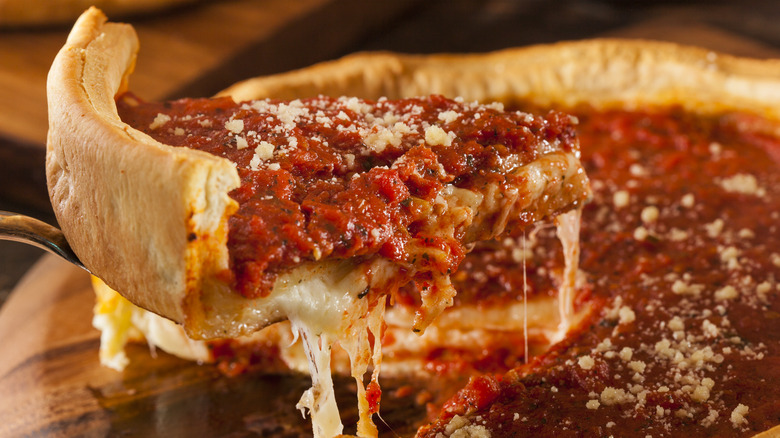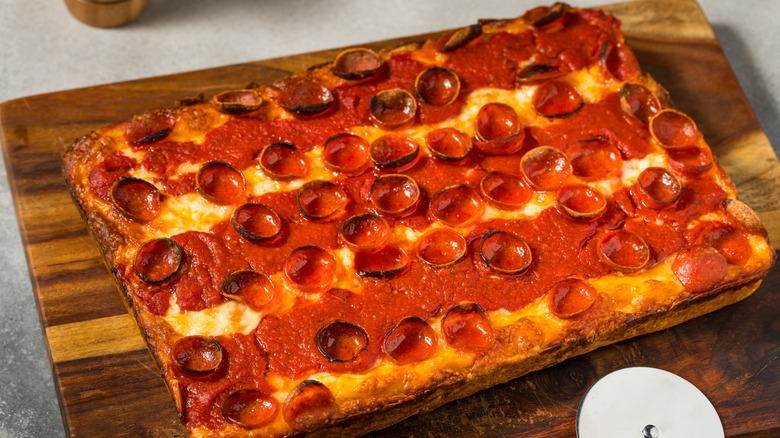Who Really Invented Chicago Deep Dish Pizza?
If you visit cities and suburbs across the United States, you'll likely come across one of 100 Pizzeria Uno locations. The franchise may not seem like an institution, but the popular pizzeria has deep roots in American culinary history as the first restaurant to serve up Chicago's famous deep dish pizza.
As the story goes, in 1943, former college football star-turned-businessman, Ike Sewell teamed up with fellow entrepreneur, Ric Riccardo, to open a restaurant on the corner of Ohio and Wabash in Chicago's Near North Side neighborhood. Initially, Sewell suggested Mexican food, but Riccardo suggested serving cuisine from his home country of Italy. Together, they agreed on pizza.
Their pie didn't look much like its thin-crusted ancestor of the old country, however. This new iteration of one of the world's most beloved foods came with a crust at least one-inch thick, loaded with gooey Italian cheeses, topped with chunky tomato sauce and spicy-sweet Italian sausage, and baked and served in a round pan. With the first serving, Sewell and Riccardo went down in history as the inventors of Chicago deep dish pizza — that is, according to some.
Although everyone acknowledges Pizzeria Uno as the first restaurant to serve deep dish pizza, not everyone agrees on its inventor. After all, Sewell and Riccardo were businessmen, not cooks. Plus, Riccardo hailed from Italy's northern region rather than Naples, the southern Italian city known for pizza.
The true inventor of the Chicago deep dish is up for debate
So, who is the true inventor of deep dish pizza? Likely, one of Pizzeria Uno's original cooking staff deserves the credit. Former kitchen employee Adolpho "Rudy" Malnati, Sr. claimed to have come up with the idea. No evidence can prove him right, but Rudy certainly knew a thing or two about pizza. He went on to establish his own restaurant in 1971, Lou Malnati's. Today, the family-run enterprise remains a local establishment with 59 locations in the Chicagoland area. His sons also opened the popular Pizano's pizza chain in Chicago.
Others point to employee and Mississippi native Alice May Redmond who may have applied her background in Southern cooking by making a thicker-than-average crust inspired by fluffy, doughy buttermilk biscuits. Unquestionably, Redmond played a role in the early days of deep dish, not only working at its premier pizzeria but later joining the second-oldest restaurant to serve Chicago-style pies, Gino's East.
The true inventor seems lost to the annals of time. But, one thing remains certain: Chicago deep dish reigns as one of the most iconic dishes from the Windy City, still beloved and served at pizzerias around the world.
How American pizzas riff off old-world styles
Authentic Chicago deep dish pizza all comes down to that buttery, biscuit-like crust baked that's 2 inches tall and housed in a circular pan with butter or corn oil. Compare that to its Neapolitan predecessor with a crust of 0.25 centimeters (a rule strictly enforced by the Associazione Verace Pizza Napoletana in their regulations).
But, that's not to confuse deep dish with another of Chicago's popular pies: its younger cousin, the stuffed pizza. Although both Chicago styles are cooked with the tomato sauce on top of the cheese, stuffed pizza receives a second thin crust above the filling, followed by a light layer of tomato sauce.
Chicago wasn't the only American city adding a new spin to the old-world pizza recipe. Over on the East coast, New York pizzerias took things in a totally different direction with their large, hand-tossed pies typically served by the slice. Or, there's San Francisco's wood-fired variation, which has featured fermented sourdough since as far back as the Gold Rush. Detroit developed its own signature, too, adapting Chicago's deep dish into a square cut, crunchy crust made with sauce, pepperoni, and Wisconsin brick cheese.
Pizza in America comes in all different shapes and sizes, a reflection of the country's melting pot merging together with influences from every corner of the world to create something altogether new and delicious. And, although the original inventors may never get the credit they deserve, their legacies remain in the heart (and bellies) of all.



